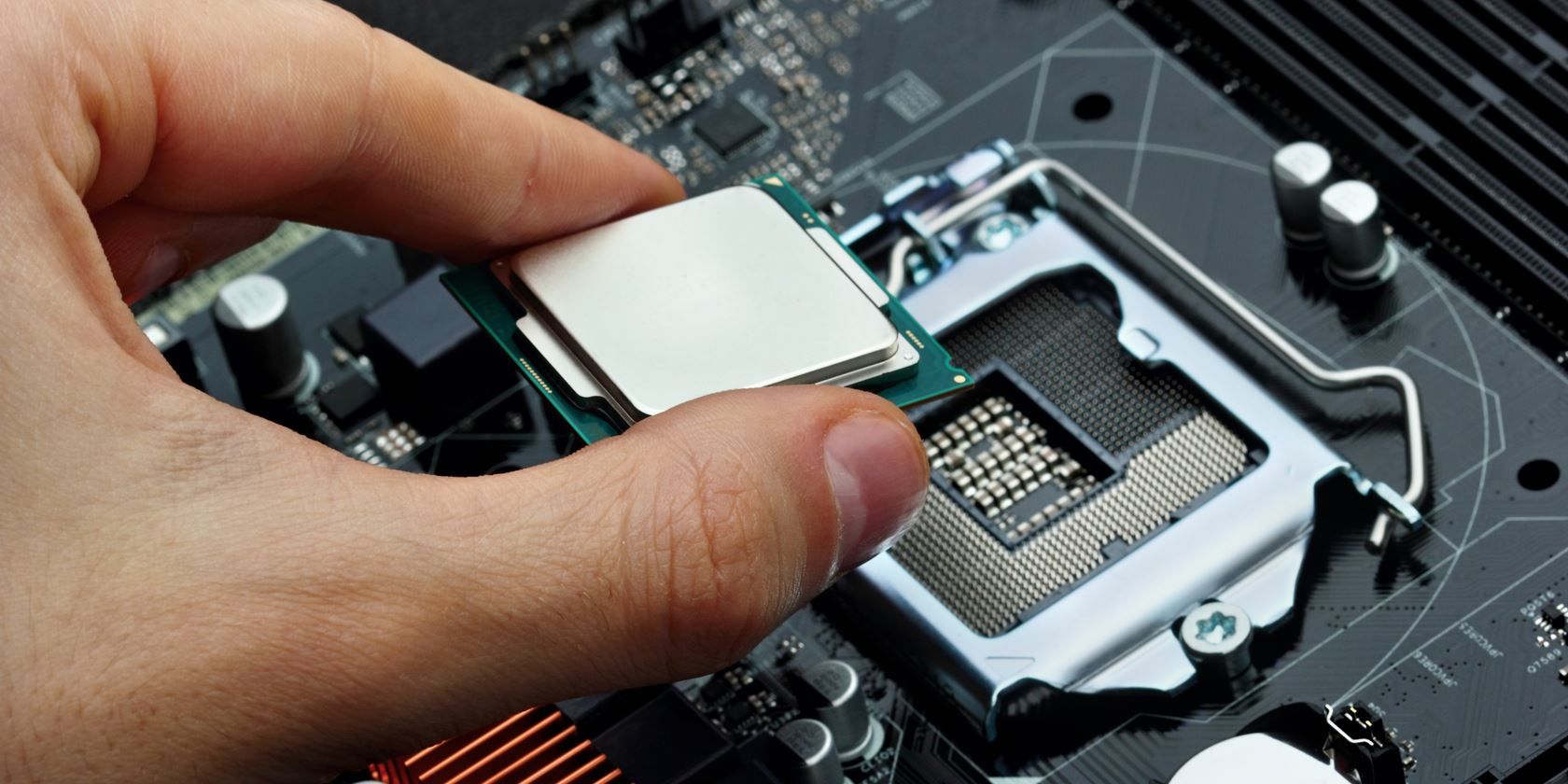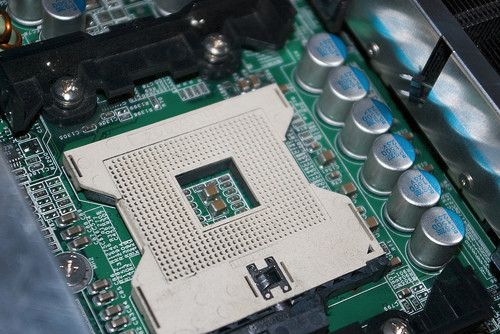
Your computer processor has a home: the socket. The CPU socket is rarely mentioned because it doesn’t help or hinder performance. Rather, it provides a standardized shape for a specific generation of CPUs.
Why, then, should you care about CPU sockets? Well, if you want to upgrade your CPU, you need to know the socket type. Your motherboard socket type dictates which type of CPU you can use, whether your CPU upgrade is worthwhile, or if you should consider upgrading your entire system.
So, what are CPU sockets, and why are they important?
What Is a CPU Socket?

Your CPU socket is similar to a light socket. A light socket makes your light bulb part of an electrical network, giving the bulb the power it needs to work. Your CPU socket makes a processor part of your computer, providing power and offering a way for the CPU to communicate with the rest of your system hardware.
Modern computers place the CPU socket on the motherboard. (Here’s a short guide to all the parts on your motherboard.) In the past, there were other CPU socket configurations, including slot-mounted processors that you insert like a modern PCI card. Today, however, you place your CPU into the socket, on the motherboard, and secure it using a latch of some sort.
CPU sockets are decades old. Intel’s famous first processor, the Intel 386, used a 132-pin PGA socket (I’ll explain this acronym in a moment). The original Intel Pentium CPU used Socket 4 and later, Socket 5.
CPU sockets are not ubiquitous. There are differences between the CPU sockets developed by Intel and AMD, relating to the differences in CPU pin configurations between the two CPU manufacturing giants.
Why Are There Different CPU Sockets?
Unlike a light socket, CPU socket design does change frequently. Why?
Well, changes to the CPU architecture are the reason. New processor architectures arrive every few years and often come with a new set of requirements, including shape, size, and motherboard compatibility. Plus, there are two major x86 processor manufacturers: AMD and Intel. AMD and Intel CPUs have separate processor architectures, and compatibility between the two is impossible.
That last statement hasn’t always been true, mind. Back in the early days of computing, if you were lucky enough to own a high-end Socket 7 motherboard, you could use an Intel Pentium, an AMD K6, K6-2, or K6-3, a Cyrix 6×86, an IDT Winchip, or a Rise Technology mP6. And while dual-CPU motherboards do exist, there aren’t any that facilitate AMD and Intel concurrently.
What Type of CPU Sockets Exist?
Over the years, many types of CPU sockets have come and gone. Only three are relevant at the current time: LGA, PGA, and BGA.
LGA and PGA
LGA and PGA can be understood as opposites. “Land grid array” (LGA) consists of a socket with pins that you place the processor on. PGA (“pin grid array”), on the other hand, places the pins on the processor, which you then insert into a socket with appropriately placed holes.
In the modern computing era, Intel CPUs use LGA sockets, while AMD CPUs use PGA. There are notable exceptions to that rule, though. For instance, the monstrous AMD Threadripper uses Socket TR4 (short for Threadripper 4), which is an LGA socket. TR4 is only AMD’s second LGA socket. Earlier Intel CPUs, such as the Pentium, Pentium 2, and Pentium 3 all used a PGA socket.
BGA
There is also a BGA socket, which stands for “ball grid array”. The BGA technique permanently attaches the processor to the motherboard during production, making upgrades impossible. A BGA socket and motherboard can potentially cost less, but there are very few equivalents between consumer BGA products, and LGA and PGA.
Furthermore, BGA technically is not a socket because it is a permanent motherboard feature. (You can easily replace an LGA or PGA CPU.) BGA sockets are still worth mentioning since it serves the same function.
Several years back there was a rumor that Intel was going to sunset the LGA socket. Intel LGA sockets would phase out after the 4th generation Intel Haswell CPUs. It never came to pass, and Intel still develops CPUs for LGA sockets.
That said, with the increase in system-on-a-chip (SoC) hardware, Intel has increased its BGA socket use. Similarly, ARM, Broadcom, Qualcomm, Nvidia, and other SoC manufacturers all rely heavily on BGA.
Does CPU Socket Type Matter?
A processor using a particular socket type will fit into any motherboard with that socket, right? Wrong!
Socket types like LGA are a category, rather than a specific model. There are many socket variations built on the basic specification.
Intel gives its LGA sockets a name based upon the number of pins. LGA1155, for example, has 1,155 individual socket pins. A processor built for that specific socket type will work only with that socket. Sometimes the numbers are incredibly similar, like LGA1155 and LGA1156, but you cannot force one into the opposing socket. A single Intel socket variation can cover multiple CPU generations.
AMD takes a slightly different approach. It labels its sockets with broad names, like AM3 or FM1. Compatibility is still strictly enforced, though AMD occasionally upgrades a socket while retaining compatibility. You can spot an upgraded AMD socket with the “+” symbol, such as AM2+ and AM3+.
Will CPU Sockets Become Extinct?
Computer development continues to feature a socket as a core design feature. Most components, including the processor, are upgradable or serviceable. Home and business users have the opportunity to build a system to whatever specification they desire, knowing that in time, they can make improvements.
The rise of mobile devices has seen a slight paradigm shift. The PC is not going extinct, far from it. But it is changing significantly to cope with the demands of the mobile hyper-networked world. The extinction of sockets could well be part of that change. CPU sockets add bulk and manufacturing complexity to products striving to reduce costs and size.
Predictions of the demise of the CPU socket in the near future are premature. You only have to look at Intel and AMD developing smaller, faster CPU manufacturing processes, as well as the development going into upgrading existing sockets or producing new socket variations.
It makes sense, too. Even though there more mobile devices than ever, enthusiasts and IT specialists will always look to a motherboard with a socket so that upgrading a single part is an option, rather than replacing an entire system, server, or otherwise.
Considering building your own PC, but not sure where to start? Look no further than our guide on how to build your own PC. It’ll walk you through, from start to finish.
Read the full article: CPU Socket Types Explained: Socket 5 to BGA
from MakeUseOf http://bit.ly/2l0U4HN

No comments:
Post a Comment